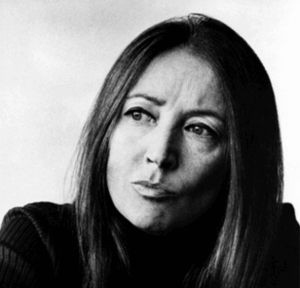Oriana Fallaci, Biography of a Witness

Oriana Fallaci was one of the most read and acclaimed journalists in the world. Her 12 books are available in over 20 languages and estimates indicate she sold at least 20 million copies of them worldwide.
Fallaci mainly stood out as an interviewer because no one could bring out the most hidden sides of celebrities and figures in positions of power like she did.
Oriana Fallaci was one of the icons of the fourth power. She showed that journalism could alter events when it followed specific principles.
Several of the most influential characters of the twentieth century passed through her recorder. Some say that everyone hated her and that, to her, it was a sign that she was doing something right.
In addition to her work as a journalist, she was also a wonderful writer. She had a direct, sensitive, and fun style that captivated several generations. She addressed all kinds of issues through her work: from the oppression of women in the Muslim world, Muhammad Ali, the Vietnam war, and the first trip to the Moon.
In fact, one of the most famous anecdotes of Oriana Fallaci regarding the trip to the Moon took place during the Apollo XII tour. Some say that Charles Conrad, the commander of the trip, sought her advice on the phrase he should say when he stepped on the satellite. Because Conrad was a short man, Fallaci advised him to say: “For Neil, it was a small step, but it’s very big for me”.

Oriana Fallaci, a partisan
Oriana Fallaci was born in Florence, Italy on June 29, 1929. Some say that her mother had a very strong personality. Her father, Edoardo, was a humble carpenter, lover of Marcel Proust’s work and a radical leftist. Oriana was his first child and he expected a boy. Thus, he raised her as one.
Her father taught her how to shoot, hunt, and endure painful situations without complaining. When fascism seized Italy, Edoardo and his daughter, who was barely 13 years old, joined the resistance. Oriana Fallaci’s father was arrested and tortured by the Nazis during their occupation of Florence. Meanwhile, she operated as human mail to the resistance.
When the war ended, the Italian army awarded her an honorary medal for her courage. Oriana Fallaci was only 14 years old at the time. An excellent student, she obtained a scholarship to study medicine. However, her destiny took her on another path; she became a journalist before the age of 20.
Witness of history
Fallaci worked for several small newspapers. At the end of the 50s, she began writing in L’Europeo magazine. They sent her to the United States to write about shows. From that experience emerged her first book, Hollywood’s Seven Deadly Sins. After that trip, Oriana felt her place was in that country and moved to New York in the early 1960s.
Later on, she embarked on a series of trips to Asia from which her books Useless Sex and Penelope at War emerged. Subsequently, she wrote a series of articles and a book on NASA’s space projects.
In 1967, she became a war correspondent and was asked to cover the Vietnam conflict. This resulted in various chronicles and one of her most famous books: Nothing, and So Be It.
She became quite famous all over the world and covered several social protests. In fact, she received multiple shots in the massacre that took place in the Plaza de las Tres Culturas in Mexico City. People thought she was dead and sent her to the morgue. Then, an official noticed that she wasn’t and sent her back to a hospital.

A woman, a legend
After that experience, her era of great interviews began. She sat at the table with the most powerful men in the world at the time. Thus, one of her memorable dialogues was with Ayatollah Khomeini. She questioned him about his religion’s treatment of women and took off the chador she had been forced to wear in front of him. She recorded most of these interviews in her book Interview with History.
In 1973, she met Alexandros Panagoulis while doing one of her interviews. He was a Greek hero who had faced the dictatorship. The two fell madly in love but their relationship ended three years later when he died. This profoundly impacted her life and she even wrote a book about him, A Man (1979). Her success continued but years later she sort of hid from the world in her New York apartment.
Then, she was diagnosed with lung cancer and 9/11 happened. After that event, she wrote so many radical articles against Islam that three governments decided to prosecute her for xenophobia. In 2006, she decided she wanted to go to Florence, Italy, as she wanted to die in her native city. Ten days later, on September 15, Oriana Fallaci died, leaving an unsurpassed journalistic legacy behind.
Oriana Fallaci was one of the most read and acclaimed journalists in the world. Her 12 books are available in over 20 languages and estimates indicate she sold at least 20 million copies of them worldwide.
Fallaci mainly stood out as an interviewer because no one could bring out the most hidden sides of celebrities and figures in positions of power like she did.
Oriana Fallaci was one of the icons of the fourth power. She showed that journalism could alter events when it followed specific principles.
Several of the most influential characters of the twentieth century passed through her recorder. Some say that everyone hated her and that, to her, it was a sign that she was doing something right.
In addition to her work as a journalist, she was also a wonderful writer. She had a direct, sensitive, and fun style that captivated several generations. She addressed all kinds of issues through her work: from the oppression of women in the Muslim world, Muhammad Ali, the Vietnam war, and the first trip to the Moon.
In fact, one of the most famous anecdotes of Oriana Fallaci regarding the trip to the Moon took place during the Apollo XII tour. Some say that Charles Conrad, the commander of the trip, sought her advice on the phrase he should say when he stepped on the satellite. Because Conrad was a short man, Fallaci advised him to say: “For Neil, it was a small step, but it’s very big for me”.

Oriana Fallaci, a partisan
Oriana Fallaci was born in Florence, Italy on June 29, 1929. Some say that her mother had a very strong personality. Her father, Edoardo, was a humble carpenter, lover of Marcel Proust’s work and a radical leftist. Oriana was his first child and he expected a boy. Thus, he raised her as one.
Her father taught her how to shoot, hunt, and endure painful situations without complaining. When fascism seized Italy, Edoardo and his daughter, who was barely 13 years old, joined the resistance. Oriana Fallaci’s father was arrested and tortured by the Nazis during their occupation of Florence. Meanwhile, she operated as human mail to the resistance.
When the war ended, the Italian army awarded her an honorary medal for her courage. Oriana Fallaci was only 14 years old at the time. An excellent student, she obtained a scholarship to study medicine. However, her destiny took her on another path; she became a journalist before the age of 20.
Witness of history
Fallaci worked for several small newspapers. At the end of the 50s, she began writing in L’Europeo magazine. They sent her to the United States to write about shows. From that experience emerged her first book, Hollywood’s Seven Deadly Sins. After that trip, Oriana felt her place was in that country and moved to New York in the early 1960s.
Later on, she embarked on a series of trips to Asia from which her books Useless Sex and Penelope at War emerged. Subsequently, she wrote a series of articles and a book on NASA’s space projects.
In 1967, she became a war correspondent and was asked to cover the Vietnam conflict. This resulted in various chronicles and one of her most famous books: Nothing, and So Be It.
She became quite famous all over the world and covered several social protests. In fact, she received multiple shots in the massacre that took place in the Plaza de las Tres Culturas in Mexico City. People thought she was dead and sent her to the morgue. Then, an official noticed that she wasn’t and sent her back to a hospital.

A woman, a legend
After that experience, her era of great interviews began. She sat at the table with the most powerful men in the world at the time. Thus, one of her memorable dialogues was with Ayatollah Khomeini. She questioned him about his religion’s treatment of women and took off the chador she had been forced to wear in front of him. She recorded most of these interviews in her book Interview with History.
In 1973, she met Alexandros Panagoulis while doing one of her interviews. He was a Greek hero who had faced the dictatorship. The two fell madly in love but their relationship ended three years later when he died. This profoundly impacted her life and she even wrote a book about him, A Man (1979). Her success continued but years later she sort of hid from the world in her New York apartment.
Then, she was diagnosed with lung cancer and 9/11 happened. After that event, she wrote so many radical articles against Islam that three governments decided to prosecute her for xenophobia. In 2006, she decided she wanted to go to Florence, Italy, as she wanted to die in her native city. Ten days later, on September 15, Oriana Fallaci died, leaving an unsurpassed journalistic legacy behind.
All cited sources were thoroughly reviewed by our team to ensure their quality, reliability, currency, and validity. The bibliography of this article was considered reliable and of academic or scientific accuracy.
Hernández González, M. B. Zangrilli, Franco. 2013. Oriana Fallaci e così sia, uno scrittore postmoderno. Pisa: Felice Editore.
This text is provided for informational purposes only and does not replace consultation with a professional. If in doubt, consult your specialist.







